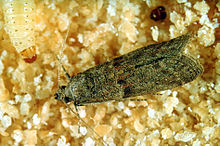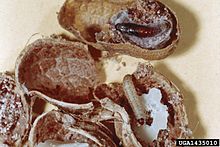| Almond moth | |
|---|---|

| |
| Caterpillar and moth | |

| |
| Caterpillar (below) and pupa (above) in peanut husks | |
| Scientific classification | |
| Domain: | Eukaryota |
| Kingdom: | Animalia |
| Phylum: | Arthropoda |
| Class: | Insecta |
| Order: | Lepidoptera |
| Family: | Pyralidae |
| Genus: | Cadra |
| Species: | C. cautella
|
| Binomial name | |
| Cadra cautella (Walker, 1863)
| |
| Synonyms | |
|
Numerous, see text | |
The almond moth or tropical warehouse moth (Cadra cautella) is a small, stored-product pest. Almond moths infest flour, bran, oats, and other grains, as well as dried fruits.[1] It belongs to the family of snout moths (Pyralidae), and more specifically to the tribe Phycitini of the huge snout moth subfamily Phycitinae. This species may be confused with the related Indian mealmoth (Plodia interpunctella) or the Mediterranean flour moth (Ephestia kuehniella), which are also common pantry pests in the same subfamily.[2]
Other common names, particularly in nonbiological literature, are dried currant moth and fig moth, which invite confusion with the close relatives Cadra figulilella (raisin moth) and Cadra calidella (dried fruit moth). Like the raisin moth, the almond moth has achieved an essentially cosmopolitan distribution due to inadvertent transport with food products in its larval form. Adults live for about 10 days after eclosion and do not eat, but may drink if water is available. The mating system is polygamous; however, many females will only mate once.
- ^ Cite error: The named reference
Grabewas invoked but never defined (see the help page). - ^ Sasaki, Tetsuhiko; Ishikawa, Hajime (1999-10-01). "Wolbachia Infections and Cytoplasmic Incompatibility in the Almond Moth and the Mediterranean Flour Moth". Zoological Science. 16 (5): 739–744. doi:10.2108/zsj.16.739. ISSN 0289-0003. S2CID 85734865.